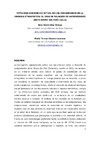Identificador persistente para citar o vincular este elemento:
https://accedacris.ulpgc.es/jspui/handle/10553/21370
| Campo DC | Valor | idioma |
|---|---|---|
| dc.contributor.author | Hernández Arroyo, Sara | en_US |
| dc.contributor.author | Cáceres-Lorenzo, MTeresa | en_US |
| dc.date.accessioned | 2017-04-18T08:36:43Z | - |
| dc.date.accessioned | 2018-03-16T09:14:39Z | - |
| dc.date.available | 2017-04-18T08:36:43Z | - |
| dc.date.available | 2018-03-16T09:14:39Z | - |
| dc.date.issued | 2016 | en_US |
| dc.identifier.issn | 1577-6921 | en_US |
| dc.identifier.uri | https://accedacris.ulpgc.es/handle/10553/21370 | - |
| dc.description.abstract | La bibliografía especializada señala que las crónicas como la Relación de antigüedades deste Reyno del Pirú (Relación), escrita en 1613, no siempre es un material idóneo para valorar el grado de asimilación de los indigenismos en la lengua española, por su finalidad instrumental etnográfica. Nuestra hipótesis de trabajo plantea que en Relación, a pesar del propósito de describir las costumbres y tradiciones de los incas, es posible examinar los indigenismos, desde el concepto de vitalidad sincrónica actual (presencia en los diccionarios actuales y riqueza semántica), porque en los diferentes textos coloniales del XVII siempre hay un número determinado de voces que evidencian la existencia de un vocabulario indiano general o regional. | en_US |
| dc.description.abstract | The referential texts such as chronicles like Relación de antigüedades deste Reyno del Pirú (Relación) prove being not always ideal to judge the grade of assimilation of indigenous voices in the Spanish language, due to its ethnographic purpose. Our working premise states that it is possible to observe indigenous vocabulary in the different colonial texts from XVII Century under the scope of current synchronous semantics (presence on current dictionaries and semantic richness) because there are always voices that demonstrate the existence of an Indian Vocabulary. The wording study of "Relación(...)" under the mentioned scope of synchronous vitality wpuld provide references about the veracity of our hypothesis. The object of this paper is to recognize signs of Andean Indian vocabulary in a text which was intended for the Ecclesiastical Powers in the Colonial Society. Through a qualitative and quantitative methodology we have developed a lexicon of 165 indigenous voices. The 37[%] have a current synchronous Hispanic or regional vitality, the 53[%] are spread on a regional basis and the 48[%] have semantic richness. This result is partially aligned with our first working premise, contributing to the historical research of the American Indian semantics as well as it opens the possibility of additional lines of research. | en_US |
| dc.language | spa | en_US |
| dc.relation.ispartof | Tonos Digital | en_US |
| dc.source | Tonos Digital [ISSN 1577-6921], v. 31, p. 130-148 | en_US |
| dc.subject | 570107 Lengua y literatura | en_US |
| dc.subject.other | Lingüística | en_US |
| dc.subject.other | Crónicas de Indias | en_US |
| dc.subject.other | Indigenismos léxicos | en_US |
| dc.subject.other | Vitalidad sincrónica | en_US |
| dc.subject.other | Diccionarios académicos | en_US |
| dc.title | Vitalidad sincrónica actual de los indigenismos en la crónica etnográfica: el caso de relación de antigüedades deste Reyno del Pirú (1613) | en_US |
| dc.title.alternative | Current synchronous vitality of indigenous voices in ethnographic chronicle: The case of Relación de antigüedades deste Reyno del Pirú (1613) | en_US |
| dc.type | info:eu-repo/semantics/Article | en_US |
| dc.type | Article | en_US |
| dc.identifier.scopus | 84973912727 | |
| dc.contributor.authorscopusid | 57189659986 | |
| dc.contributor.authorscopusid | 57189660014 | |
| dc.identifier.crisid | -;1412 | - |
| dc.description.lastpage | 148 | - |
| dc.description.firstpage | 130 | - |
| dc.relation.volume | 31 | - |
| dc.investigacion | Artes y Humanidades | en_US |
| dc.rights.accessrights | info:eu-repo/semantics/openAccess | es |
| dc.type2 | Artículo | en_US |
| dc.date.coverdate | Junio 2016 | |
| dc.identifier.ulpgc | Sí | es |
| dc.description.sjr | 0,1 | |
| dc.description.sjrq | Q4 | |
| dc.description.dialnetimpact | 0,0 | |
| dc.description.dialnetq | Q2 | |
| dc.description.dialnetd | D5 | |
| dc.description.erihplus | ERIH PLUS | |
| item.fulltext | Con texto completo | - |
| item.grantfulltext | open | - |
| crisitem.author.dept | GIR IATEXT: Cognición, Lingüística, Texto y Procesamiento de la Información | - |
| crisitem.author.dept | IU de Análisis y Aplicaciones Textuales | - |
| crisitem.author.dept | Departamento de Filología Hispánica, Clásica y de Estudios Árabes y Orientales | - |
| crisitem.author.dept | GIR IATEXT: División de Estudios de Corpus y Lingüística Aplicada | - |
| crisitem.author.dept | IU de Análisis y Aplicaciones Textuales | - |
| crisitem.author.dept | Departamento de Filología Hispánica, Clásica y de Estudios Árabes y Orientales | - |
| crisitem.author.orcid | 0000-0001-8458-9809 | - |
| crisitem.author.orcid | 0000-0002-1683-9025 | - |
| crisitem.author.parentorg | IU de Análisis y Aplicaciones Textuales | - |
| crisitem.author.parentorg | IU de Análisis y Aplicaciones Textuales | - |
| crisitem.author.fullName | Hernández Arroyo, Sara | - |
| crisitem.author.fullName | Cáceres Lorenzo, M. Teresa | - |
| Colección: | Artículos | |
Visitas
138
actualizado el 27-jul-2024
Descargas
109
actualizado el 27-jul-2024
Google ScholarTM
Verifica
Comparte
Exporta metadatos
Este elemento está sujeto a una licencia Licencia Creative Commons

